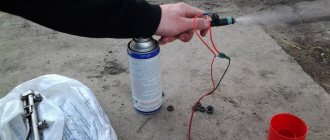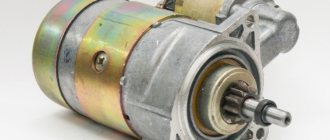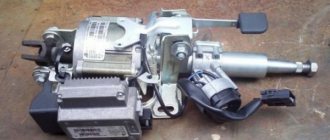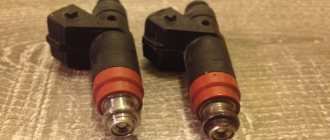Why flush the injector?
But now I will express my opinion on this matter in more detail.
Let’s start with the fact that I don’t quite understand the expression “wash the injector”, wash the nozzles on the injector”, “injector car” and the like. What is an injector? injector in translation is a nozzle. Just a nozzle.
Now let’s write these expressions in translation - “rinse the injector” (one??? Maybe it would be more correct to rinse the injectors?), “rinse the injectors on the injector”, “injector car”. Sounds like complete nonsense to me. And the meaning is even crazier
It is more correct, in my opinion, to put it this way: “wash the injectors on a car with an engine management system”
But washing the injectors without removing them from the car is an ineffective measure. Therefore, I only wash the injectors when removing them from the engine. This way you can visually evaluate the spray pattern of the injectors and check their shut-off properties. Look them in the eye, so to speak.
You can read about this in the article How to clean injectors
So why “wash the injector without removing the injectors”?
The fact is that this procedure is necessary not only on injection engines (engine with a control system), but also on carburetor engines (without an engine control system)
Do you get the point? This flush is also intended for carburetor engines, although there are no injectors. So what is there to rinse? And during this procedure the valves and combustion chamber are washed.
This is what we will be doing next, and not flushing the injector, as many people think. After all the procedures, I, dear Friends, will show you the result in numbers, so to speak.
Okay, it’s clear that we will wash the valves and combustion chambers. But why? What's so scary about it?
It's all about the design and operating principle of most injector engines.
Injectors replaced carburetors primarily for environmental reasons. By using the engine management system, emissions of harmful substances can be reduced. The injectors also made it possible to make the intake manifold dry and provide a more uniform fuel supply to each combustion chamber, which was not possible to achieve with a carburetor.
So here it is. The injector delivers fuel on our engines not directly into the combustion chamber, but into the intake manifold next to the intake valve. This is a very smart solution, since it is not gasoline that burns in the combustion chamber, but gasoline vapors with air. This is where “valve injection” plays a very important role, since the valve is hot, the fuel hitting it evaporates very quickly and mixes with air. This is very good.
But there is also another side to the coin. You always have to win something and lose something. So it is in this case.
When fuel hits a hot valve, it inevitably leaves traces of scale, all kinds of sediment, deposits, etc. on it.
Over time, the valve becomes more and more overgrown with this muck. And this muck, in turn, interferes with the evaporation of fuel. As a result, mixture formation is difficult, engine starting takes longer, and the opening time of the injectors at idle increases from 2.5 ms to 3, or even 4 ms. Hence the increased consumption, loss of throttle response at low speeds and other delights.
Carbon deposits in the combustion chamber also do not bring anything good. In particularly advanced cases, it can even lead to detonation, which is a direct threat to the engine.
So think - do the engine good now or continue to doubt the usefulness of this procedure
In order to more realistically demonstrate to you the result of flushing the valves, I washed the injectors in advance by removing them from the engine, and also did diagnostics of the engine before flushing, during flushing and after flushing. I also unscrewed one candle for a clear picture of what was happening. You don't need to do this.
So, let's go.
When things get tough
If the nozzle is clean, then a cone-shaped projection is sprayed at the output, and the flame burns evenly and without interruption. But over time, it becomes clogged and its performance decreases.
Typical signs of contamination include:
- difficulty starting the engine;
- deterioration of its draft properties;
- unstable operation in idle mode (vibration, interruptions);
- increased fuel consumption;
- smoky intake from the muffler;
- soot formation on candles;
- The "Check Engine" indicator is illuminated.
It is advisable to clean the injector once every 50 thousand km, more often is better.
There are 2 methods of cleaning the injector - ultrasonic and chemical. The cost of the first method is significantly higher than the second. The average cost of washing one part is 30 - 50 USD. e.
Ultrasonic cleaning
This method is carried out only in specialized workshops on special ultrasonic stands. It involves removing the injectors from the engine and immersing them in a bath filled with a chemical solution. Cleaning occurs due to wave-like microscopic explosions.
With the help of ultrasound, old deposits are peeled off in the deepest areas of a given spare part.
On a note!
- This method is suitable for cars with high mileage.
- Fragile ceramic nozzles should only be washed with ultrasound.
Flushing the injector, valves and combustion chamber
First, I’ll tell you about the preparatory nuances and safety. In this article, washing will be done using a plastic bottle. Please be aware that this is very dangerous. Plastics and flammable materials sometimes spontaneously ignite even from static electricity. Before my eyes, a fuel warehouse once burned down simply because a person poured gasoline into a plastic canister! Therefore, it is better to use a metal container for these purposes.
I used to have a homemade metal structure. Just a piece of pipe, and plugs with fittings are welded along the edges. But the looters did not disdain her either. It is not yet possible to weld another one, since the welding machine also went in an unknown direction. And we don’t have any more electricity than we have because of the shelling.
So keep this in mind and keep a fire extinguisher handy.
Do not hang the flush container by the hood above the engine compartment. Place the container outside the engine compartment. If, God forbid, the container bursts, the flushing will not spill onto the hot engine.
I’ll also focus on the filter. I don't use it when washing. I see no reason for the extra costs. But if you still use a filter, then do it wisely, and not according to the advice from YouTube, where one advises not to spend money and take a regular plastic carburetor filter. Such advice will sooner or later lead to trouble. These filters are not designed for pressures such as those in engines with a control system, which reach values above 4 atm. That's why our filters are made of metal, not plastic.
Remember - safety comes first!
Now about some nuances. It is advisable to have a set of old working spark plugs and install them while washing. I do this. Although on the new cans of Vince they already write that it is safe for spark plugs. Therefore, decide for yourself, but then I will show you what a candle can turn into during washing.
It is recommended to start flushing with a warm engine so that less fluid leaks into the crankcase. So, it seems that you don’t have to change the oil after the flushing procedure. But I start doing this on a cold engine. Why?
Firstly, I always do an injector flush before a scheduled oil change. Secondly, in my personal opinion, when starting a cold engine, some of the flushing will get on the rings, which will increase the chance of their decarbonization or prevent the rings from sticking.
Note. The modern composition of Vince does not require the mandatory replacement of spark plugs and oil
What is needed to flush the injector:
- Vince 1 can
- rags
- two valves for tubeless tires
- 1 meter of fuel hose with an internal diameter of 10mm
- plastic bottle 2l
- compressor or pump
- drill 10mm
- two clamps 12-20
I won’t show you in detail how to make a washing container from a bottle. If you have any questions, ask in the comments.
We simply drill holes with a 10mm drill in the bottom of the bottle and in the cap. It is important that the holes are smooth and not oval. Then we insert valves for tubeless tires into them.
To insert it into the bottom of the bottle, I put the valve on the welding electrode and, with its help, inserted the valve into the bottom of the bottle.
There is no need to close the valve all the way. The pressure will then press him tightly.
Attention! If you don’t want to bother with hoses and a bottle, then you can buy a ready-made washing kit. It has many adapters and accessories. Everything is in a convenient case. You can buy it here
Go.
First of all, remove the cover from the fuse box in the engine compartment and remove the fuel pump power circuit fuse
We start the engine and let it run until it stops on its own. After this, turn the starter a couple more times. All of the above procedures are needed to relieve pressure in the fuel line.
Now, pressing the plastic lock, remove the tube from the fuel rail. If you do this on a hot engine, then it makes sense to place a wet rag underneath so that the gasoline remaining in the ramp does not get on the hot engine
The hose itself can be covered, for example, with a bag and tied
We connect our prepared fuel hose to the ramp. Do not use the first tubes or transparent hoses you come across without reinforcement - they may not withstand the pressure!
We fix the second end of the hose with a clamp to the valve installed in the bottle.
Important!!! The spool itself must first be unscrewed from this valve. He's not needed there!
Connect the compressor to the valve in the lid and fix the bottle
This is what everything looks like assembled
Screw in another set of spark plugs
Now we pour Vince into the bottle and use a compressor or pump to pump up a pressure of 4 atm, simultaneously checking the connections so that there are no leaks anywhere.
We start the engine and let it idle for 20 minutes. At first it may stall and even try to stall. At this moment, you can help him with the accelerator pedal. After some time, the speed usually becomes stable and the engine runs confidently.
We monitor the pressure and, if necessary, pump it up to 4 bar. By the way, you have to pump it up very rarely.
Attention! If you are not sure about your bottle, then you can pump up the pressure to 2.5-3 bar. This way, everything will be washed off, it’s just that the engine will not work very stably and there will be dips when opening the throttle. But it will save you from troubles. Vince is very aggressive towards plastic and will inevitably leave marks on it if he rips the valve out of the bottle.
For those who are especially curious, I’ll note that after 95 gasoline, on Vince the corrections went up sharply
After the engine has been idling for 20 minutes, it must be stopped and allowed to stand for another 20 minutes.
Then we start the engine again and periodically raise the speed to 3 thousand. Hold this for a minute and reduce the speed. We repeat this sequence until all the washing liquid is gone.
Important!!! Raising the speed does not mean “losing the throttle”! The speed must be increased gradually. By sharply accelerating you will do more harm than good, since in this case a strong detonation will appear! Keep this in mind.
After Vince runs out, release the pressure in the bottle, reconnect the fuel line to the ramp, screw on the gas cap, insert the fuel pump fuse and start the engine on gasoline. Let it work in different modes for 20 minutes.
After this, change the engine oil and oil filter. How to do this is outlined on the Chevrolet Lacetti oil change page.
After changing the oil, we change the spark plugs and go for a drive in active mode for 20 minutes.
For those who are thinking about whether to change spark plugs or not, I’ll just show you a photo for general development.
On the right is the candle before washing begins, and on the left is what it turns into during washing
Well, now the most important thing is what have we achieved?
Well, the first is a clear increase in engine output. Especially at low speeds. Pulling away becomes clearly better and more confident. The idle speed is leveled out.
Feelings are sensations, but let's look at the numbers. They will definitely tell us the truth.
Here is the schedule before flushing the injector and valves
And here are the same parameters after washing the injector and valves
We have amazing results - the throttle valve has closed more than one and a half times, and the pressure in the manifold has decreased from 35 kPa to 31 kPa.
Here are some more impressive results. Engine operation before valve flushing
And here is the engine operation after flushing the valves
Notice how RHH’s steps have dropped by half? What about air consumption?
And finally, the most informative indicator for many. Here is the duration of the injection pulse before flushing the injector
But the duration of the injection pulse after flushing the injector
Not only did the duration of the injection pulse decrease after flushing the injector, but it also became more stable (the line on the graph became smoother).
So not only the engine, but also your wallet will thank you. The difference at first glance is not great, but over the course of a year you can save quite a bit of expensive gasoline.
In general, let's summarize.
Everyone decides for themselves what to do with their car, but I believed, believe and will continue to believe that flushing the injector is a necessary preventative procedure. Even if nothing changed on the graphs, you still need to wash it. After all, you change the oil for some reason, but this does not affect the behavior of the car. Right?
You just need to understand that we wash not so much the injectors, but the valves and combustion chamber. And we do this for preventive purposes, rather than trying to restore a burnt valve or resurrect a dead injector.
If you have any questions, additions or advice, you are welcome to comment below.
Replacing injectors
Of course, a car service center can replace the injectors for you. The price for this service starts from 1500 rubles. However, to save time and money, it makes sense to change the injectors yourself.
Removing injectors yourself
Here is a simple algorithm for removing injectors that all car owners can perform.
1.Disconnect the negative terminal from the battery
2.Take two 17mm wrenches and relieve the fuel pressure by unscrewing the fuel pipe fittings.
3. Separate the electrical connector from the fuel rail.
4.Take a Phillips screwdriver, unscrew the screw on the bracket on which the fuel pipes are attached, and remove it.
5.Use a 5mm hexagon to unscrew the two screws on the fuel rail mounting
6. Move the ramp in the direction of the injector axis, remove all 4 injectors from the engine and remove the ramp towards the left side of the vase.
7.Press the spring clip (1) located on the injectors, move it aside, and disconnect the electrical connector (2)
8.Using a screwdriver, move the injector clamp along the ramp and remove it (on new ramps, the bracket is simply removed).
9.Remove the nozzle from the hole on the ramp, slightly rocking it from side to side.
10.Remove the O-rings that are located on the nozzle body and sprayer using a thin screwdriver
That's all, now the injectors are ready for cleaning.
Do-it-yourself injector cleaning
For cleaning you will need electrical tape (wire) to secure the joints, a carburetor cleaner in a can, a syringe and a thin tube. The cleaning algorithm is as follows.
1.Insert the tube into the cap (nozzle) of the can 2.Insert the end of the tube into the hole of the syringe (without a needle) 3.Attach the end of the syringe to the nozzle 4.Start injecting the product through the tube, simulating fuel injection.
You need to inject until the coming out stream becomes smooth and clean. Then this will mean that the injector is clean.
Another way, if you have a battery nearby, you can try applying voltage to the injector with ordinary wires (polarity does not matter) simulating their operation and at the same time spraying liquid to clean the carburetor.
After this, you need to put on new O-rings and you can begin assembly, having first checked the resistance, which should be in the range of 11-15 Ohms. Reassemble the injectors in the reverse order of disassembly.
Ultrasonic cleaning
If you don’t want to waste time and effort on constructing a stand for washing yourself, then you should just contact a car service center. Increasingly, ultrasonic cleaning services are provided there, which are very effective. It allows you to solve even the most complex and long-standing contaminants that conventional washing cannot remove. The removed injector is placed on special equipment that simulates engine operation. Flushing liquid is introduced into the fuel system, after which the effect of cavitation is achieved - the formation of air bubbles. It is thanks to this effect that the desired result can be achieved.











